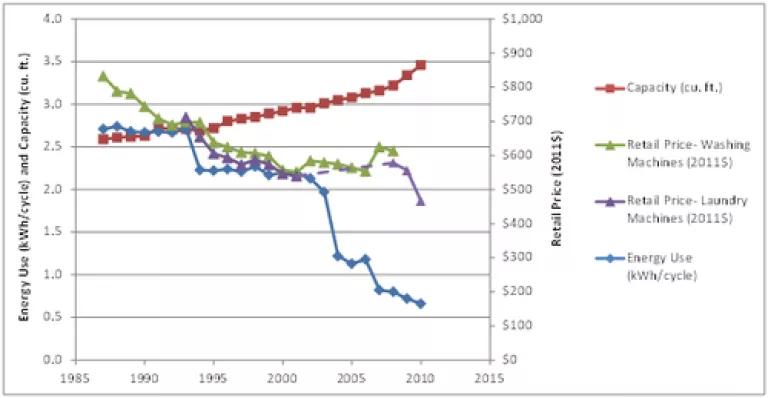A new report out today shows that when it comes to appliance efficiency standards, we really can have our cake and eat it too. Not only do energy-savings standards save homeowners and businesses money and reduce pollution, the products continue to provide the same, if not better, services to consumers.
I’ve blogged before about the tremendous benefits of the appliance efficiency standards set by the Department of Energy: existing standards reduced US electricity use by 7 percent in 2010, will save consumers over a trillion dollars cumulatively through 2035, and reduce carbon dioxide emissions by 470 million metric tons annually in 2035, equivalent to the emissions of 118 coal-fired power plants. Today’s report, entitled “Better Appliances: An Analysis of Performance, Features and Price as Efficiency has Improved,” reaffirms the advantages of standards and shows they provide these advantages while continuing to provide high-performing options to consumers.
Published by the American Council for an Energy-Efficient Economy (ACEEE) and the Appliance Standards Awareness Project (ASAP) , the analysis looks at the effects of standards over time on the options available to consumers for 10 residential, consumer, and lighting products, including refrigerators, washing machines, toilets, air conditioners and heat pumps, and light bulbs. The report finds that, in general, product performance has stayed the same or improved as standards have gone into effect for the 10 products and that manufacturers are offering a greater range of product features to consumers than before.
In fact, the report says that standards can actually encourage innovation, leading to a wider range of product options and at lower costs. This is because standards are generally performance-based and do not require specific design or technology options, encouraging manufacturers to meet the given energy or water use level at the lowest cost. An example of this is the light bulb efficiency standards, which are driving innovation in lighting technologies, including high efficiency incandescent bulbs that use 28 percent less energy than a traditional incandescent, while continuing to offer the same product features (brightness, color temperature, dimmability, and lifespan).
The report also finds that for about half the products, retail prices stayed the same or declined after the standards took effect. For the other half, incremental cost increases were more than paid back in energy savings (and these cost increases weren’t necessarily wholly attributable to the standards). The chart below illustrates this for washing machines: over time average capacity has gone up, while price and energy use have decreased with the implementation of standards.
Clothes washer energy use, volume, and retail price from 1987-2010

Source: ASAP and ACEEE, Better Appliance: An Analysis of Performance, Features, and Price as Efficiency Has Improved
The results of the report are not surprising: product performance and features are taken into account when standards are set and many of the standards have been the result of negotiated agreements between manufacturers, consumer groups, and efficiency advocates, who all want to maintain product performance and feature availability. But today’s report is the first to look at the effect of appliance standards on choice in a comprehensive, empirical way. For each of the 10 products, the authors looked at market share, product availability, price, and performance data before and after the standards took effect:
- For seven of 10 products (residential and commercial central air conditioners and heat pumps, toilets, general service light bulbs, incandescent reflector lamps, fluorescent lamp ballasts, and refrigerated vending machines), they looked at the effects of the current standard (which for three of the products was the first ever national standard).
- For the other three products (refrigerators, washing machines, and dishwashers), there was enough historical data to look at the effects of multiple standards over a 20-25 year period.
For almost all products, ACEEE and ASAP report product performance stayed the same or improved after the standards took effect. Their assessment of performance depended on the specific product and included features such as size, noise-level, cycle-time, washing performance, cooling performance, availability of features, dimmability, color quality and others. For two standards, the 2007 washing machine standard and the 1994 toilet standard, the report says that immediately after the implementation of standards there was a temporary increase in the number of poorly performing products (i.e., a year or two) while manufacturers adjusted to the standards. However, they quickly adjusted and there are many toilets today that provide excellent flush performance. Clothes-washing also improved quickly and there are now many models, including at low-price points that receive high rankings for washing performance. This is alongside the introduction of many other new features, such as larger tub capacities, steam cycles, electronic controls, gentler wash cycles, and more.
The report emphasizes the tremendous benefits of standards and shows that they’ve achieved these benefits while continuing to provide a wide array of choices to consumers.
With today’s report, recently confirmed Secretary of Energy Ernest Moniz has one more reason to act quickly to finalize overdue appliance standards pending at the OMB’s Office of Information and Regulatory Affairs (OIRA) and work to meet deadlines for other standards throughout his term. Each day of delay on the eight overdue standards costs consumers and businesses about $10 million in lost savings, and produces over 100,000 metric tons of global warming pollution, alone, according to the Appliance Standards Awareness Project. Acting on appliance standards will save consumers money, reduce pollution because less energy is needed to operate them, create jobs, and continue to provide high-performing options to customers.



